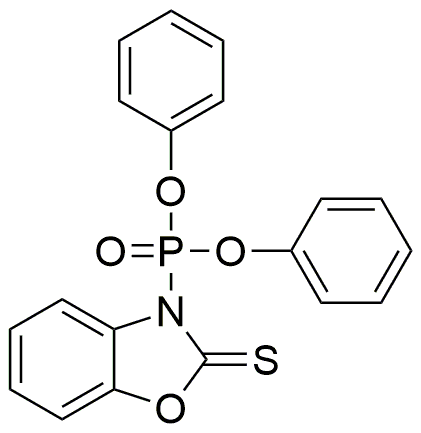Diphenyl (2,3-Dihydro-2-thioxo-3-benzoxazolyl)phosphonate is widely utilized in research focused on:
- Pharmaceutical Development: This compound serves as a key intermediate in the synthesis of various pharmaceutical agents, particularly those targeting neurological disorders. Its unique structure allows for the development of drugs with enhanced efficacy and reduced side effects.
- Agricultural Chemicals: It is used in formulating pesticides and herbicides, providing effective solutions for crop protection. Its ability to inhibit specific enzymes makes it valuable for developing targeted agricultural products.
- Material Science: The compound is employed in the creation of advanced materials, including polymers and coatings, that require specific chemical properties for durability and resistance to environmental factors.
- Analytical Chemistry: It acts as a reagent in various analytical techniques, helping researchers detect and quantify other compounds in complex mixtures, thus enhancing the accuracy of chemical analyses.
- Environmental Monitoring: The compound is utilized in the development of sensors for detecting pollutants, contributing to efforts in environmental protection and sustainability by enabling real-time monitoring of hazardous substances.
General Information
Properties
Safety and Regulations
Applications
Diphenyl (2,3-Dihydro-2-thioxo-3-benzoxazolyl)phosphonate is widely utilized in research focused on:
- Pharmaceutical Development: This compound serves as a key intermediate in the synthesis of various pharmaceutical agents, particularly those targeting neurological disorders. Its unique structure allows for the development of drugs with enhanced efficacy and reduced side effects.
- Agricultural Chemicals: It is used in formulating pesticides and herbicides, providing effective solutions for crop protection. Its ability to inhibit specific enzymes makes it valuable for developing targeted agricultural products.
- Material Science: The compound is employed in the creation of advanced materials, including polymers and coatings, that require specific chemical properties for durability and resistance to environmental factors.
- Analytical Chemistry: It acts as a reagent in various analytical techniques, helping researchers detect and quantify other compounds in complex mixtures, thus enhancing the accuracy of chemical analyses.
- Environmental Monitoring: The compound is utilized in the development of sensors for detecting pollutants, contributing to efforts in environmental protection and sustainability by enabling real-time monitoring of hazardous substances.
Documents
Safety Data Sheets (SDS)
The SDS provides comprehensive safety information on handling, storage, and disposal of the product.
Product Specification (PS)
The PS provides a comprehensive breakdown of the product’s properties, including chemical composition, physical state, purity, and storage requirements. It also details acceptable quality ranges and the product's intended applications.
Certificates of Analysis (COA)
Search for Certificates of Analysis (COA) by entering the products Lot Number. Lot and Batch Numbers can be found on a product’s label following the words ‘Lot’ or ‘Batch’.
*Catalog Number
*Lot Number
Certificates Of Origin (COO)
This COO confirms the country where the product was manufactured, and also details the materials and components used in it and whether it is derived from natural, synthetic, or other specific sources. This certificate may be required for customs, trade, and regulatory compliance.
*Catalog Number
*Lot Number
Safety Data Sheets (SDS)
The SDS provides comprehensive safety information on handling, storage, and disposal of the product.
DownloadProduct Specification (PS)
The PS provides a comprehensive breakdown of the product’s properties, including chemical composition, physical state, purity, and storage requirements. It also details acceptable quality ranges and the product's intended applications.
DownloadCertificates of Analysis (COA)
Search for Certificates of Analysis (COA) by entering the products Lot Number. Lot and Batch Numbers can be found on a product’s label following the words ‘Lot’ or ‘Batch’.
*Catalog Number
*Lot Number
Certificates Of Origin (COO)
This COO confirms the country where the product was manufactured, and also details the materials and components used in it and whether it is derived from natural, synthetic, or other specific sources. This certificate may be required for customs, trade, and regulatory compliance.


